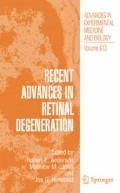Retinoschisin (RS), the product of the RS1 gene on the X-chromosome (Xp22), is a 24 kDa secreted protein which is expressed exclusively in the retina (Reid et al., 1999; Sauer et al., 1997) and pineal gland (Takada et al., 2006). In the retina, photoreceptors, bipolar cells, and ganglion cells synthesize RS (Takada et al., 2004). The structural features and functional implications of the 224 amino acid RS sequence include a N-terminus signal peptide (amino acids 1–23) and a 157 amino acid (amino acids 68–217) discoidin domain (Reid et al., 1999; Sauer et al., 1997). The signal peptide guides the secretion of mature RS across the plasma membrane and is cleaved off during the translocation process (Molday, 2007).
Access this chapter
Tax calculation will be finalised at checkout
Purchases are for personal use only
Preview
Unable to display preview. Download preview PDF.
References
Apushkin, M. A., and Fishman, G. A. (2006). Use of dorzolamide for patients with X-linked retinoschisis. Retina 26, 741–745.
Donahue, L. R., Chang, B., Mohan, S., Miyakoshi, N., Wergedal, J. E., Baylink, D. J., Hawes, N. L., Rosen, C. J., Ward-Bailey, P., Zheng, Q. Y., et al. (2003). A missense mutation in the mouse Col2a1 gene causes spondyloepiphyseal dysplasia congenita, hearing loss, and retinoschisis. J Bone Miner Res 18, 1612–1621.
Fraternali, F., Cavallo, L., and Musco, G. (2003). Effects of pathological mutations on the stability of a conserved amino acid triad in retinoschisin. FEBS Lett 544, 21–26.
Gilbert, G. E., and Drinkwater, D. (1993). Specific membrane binding of factor VIII is mediated by O-phospho-L-serine, a moiety of phosphatidylserine. Biochemistry 32, 9577–9585.
Molday, R. S. (2007). Focus on molecules: Retinoschisin (RS1). Exp Eye Res 84, 227–228.
Reid, S. N., Akhmedov, N. B., Piriev, N. I., Kozak, C. A., Danciger, M., and Farber, D. B. (1999). The mouse X-linked juvenile retinoschisis cDNA: expression in photoreceptors. Gene 227, 257–266.
Reid, S. N., and Farber, D. B. (2005). Glial transcytosis of a photoreceptor-secreted signaling protein, retinoschisin. Glia 49, 397–406.
Sauer, C. G., Gehrig, A., Warneke-Wittstock, R., Marquardt, A., Ewing, C. C., Gibson, A., Lorenz, B., Jurklies, B., and Weber, B. H. (1997). Positional cloning of the gene associated with X-linked juvenile retinoschisis. Nat Genet 17, 164–170.
Schagger, H., and von Jagow, G. (1991). Blue native electrophoresis for isolation of membrane protein complexes in enzymatically active form. Anal Biochem 199, 223–231.
Sikkink, S. K., Biswas, S., Parry, N. R., Stanga, P. E., and Trump, D. (2006). X-Linked Retinoschisis: An Update. J Med Genet 44, 225–232.
Steiner-Champliaud, M. F., Sahel, J., and Hicks, D. (2006). Retinoschisin forms a multi-molecular complex with extracellular matrix and cytoplasmic proteins: interactions with beta2 laminin and alphaB-crystallin. Mol Vis 12, 892–901.
Takada, Y., Fariss, R. N., Møller, M., Bush, R. A., Rushing, E. J., Sieving, P. A., and Bush, R. A. (2006). Retinoschisin expression and localization in rodent and human pineal and consequences of mouse RS1 gene knockout. Mol Vis 12, 1108–1116.
Takada, Y., Fariss, R. N., Tanikawa, A., Zeng, Y., Carper, D., Bush, R., and Sieving, P. A. (2004). A retinal neuronal developmental wave of retinoschisin expression begins in ganglion cells during layer formation. Invest Ophthalmol Vis Sci 45, 3302–3312.
Valencia, A., Pestana, A., and Cano, A. (1989). Spectroscopical studies on the structural organization of the lectin discoidin I: analysis of sugar- and calcium-binding activities. Biochim Biophys Acta 990, 93–97.
Vijayasarathy, C., Gawinowicz, M. A., Zeng, Y., Takada, Y., Bush, R. A., and Sieving, P. A. (2006). Identification and characterization of two mature isoforms of retinoschisin in murine retina. Biochem Biophys Res Commun 349, 99–105.
Vijayasarathy, C., Takada, Y., Zeng, Y., Bush, R. A., and Sieving, P. A. (2007). Retinoschisin is a peripheral membrane protein with affinity for anionic phospholipids and affected by divalent cations. Invest Ophthalmol Vis Sci 48, 991–1000.
Vogel, W. F., Abdulhussein, R., and Ford, C. E. (2006). Sensing extracellular matrix: An update on discoidin domain receptor function. Cell Signal 18, 1108–1116.
Wang, T., Zhou, A., Waters, C. T., O’Connor, E., Read, R. J., and Trump, D. (2006). Molecular pathology of X linked retinoschisis: mutations interfere with retinoschisin secretion and oligomerisation. Br J Ophthalmol 90, 81–86.
Weber, B. H., Schrewe, H., Molday, L. L., Gehrig, A., White, K. L., Seeliger, M. W., Jaissle, G. B., Friedburg, C., Tamm, E., and Molday, R. S. (2002). Inactivation of the murine X-linked juvenile retinoschisis gene, Rs1h, suggests a role of retinoschisin in retinal cell layer organization and synaptic structure. Proc Natl Acad Sci U S A 99, 6222–6227.
Zeng, Y., Takada, Y., Kjellstrom, S., Hiriyanna, K., Tanikawa, A., Wawrousek, E., Smaoui, N., Caruso, R., Bush, R. A., and Sieving, P. A. (2004). RS-1 Gene delivery to an adult Rs1h knockout mouse model restores ERG b-wave with reversal of the electronegative waveform of X-linked retinoschisis. Invest Ophthalmol Vis Sci 45, 3279–3285.
Author information
Authors and Affiliations
Corresponding author
Editor information
Editors and Affiliations
Rights and permissions
Copyright information
© 2008 Springer Science+Business Media, LLC
About this chapter
Cite this chapter
Vijayasarathy, C., Takada, Y., Zeng, Y., Bush, R.A., Sieving, P.A. (2008). Organization and Molecular Interactions of Retinoschisin in Photoreceptors. In: Anderson, R.E., LaVail, M.M., Hollyfield, J.G. (eds) Recent Advances in Retinal Degeneration. Advances in Experimental Medicine and Biology, vol 613. Springer, New York, NY. https://doi.org/10.1007/978-0-387-74904-4_34
Download citation
DOI: https://doi.org/10.1007/978-0-387-74904-4_34
Publisher Name: Springer, New York, NY
Print ISBN: 978-0-387-74902-0
Online ISBN: 978-0-387-74904-4
eBook Packages: MedicineMedicine (R0)

